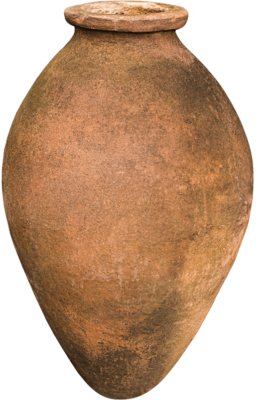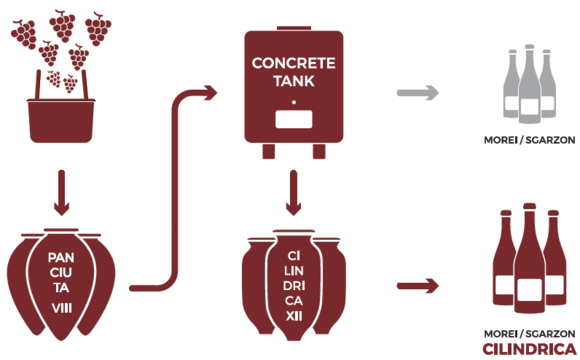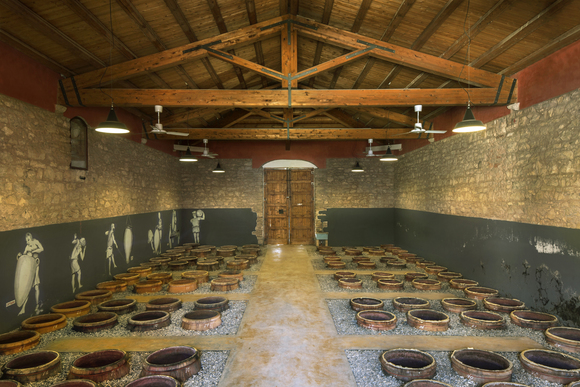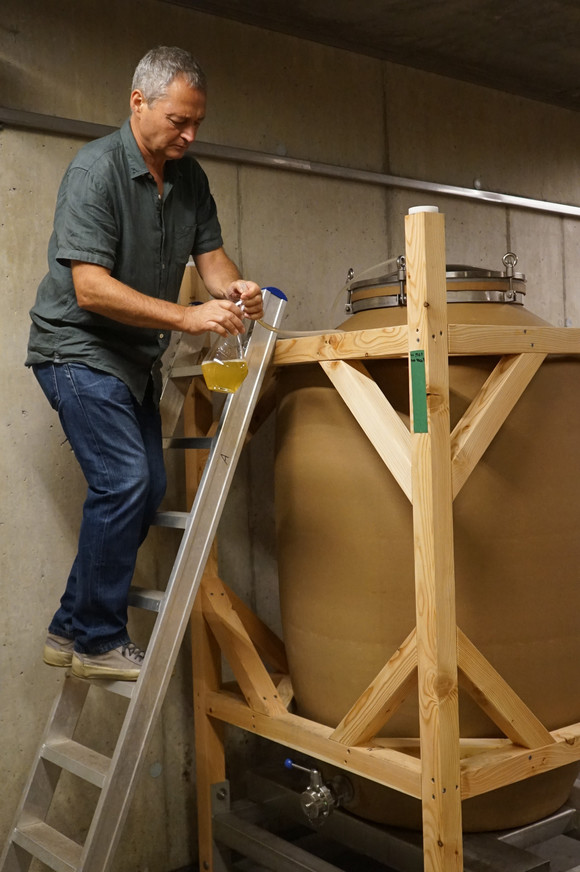The return of the amphora to modern viticulture is undoubtedly one of the most fascinating phenomena of the last two decades. Hardly any other ancient winemaking method has received as much attention in the past fifteen years as ageing in these earthenware vessels, which have been used to make wine for around 4,000 years. The origins of this method probably lie in the Near East and around the Black Sea, where the first documented winemaking processes originated. In Georgia in particular, this tradition has survived to the present day under the name Quevri. Interestingly enough, wine was also produced in amphorae in the distant south of Portugal until well into the 20th century. A closer look reveals significant differences: Georgian quevris are made of porous clay, which is permeable to liquids and is therefore lined with beeswax. They are completely buried in the ground, leaving only the opening visible. The traditional cellar amphorae from Portugal, Spain and Italy, on the other hand, were and are often only partially buried or not buried at all and are fired in such a way that they can 'breathe' micro-oxidatively, but are basically impermeable to liquids.
The rediscovery of the amphora

The renaissance of these millennia-old vessels began in the 1990s in the Collio hills of Friuli on the Italian-Slovenian border. There, pioneers such as Joško Gravner and Stanko Radikon made a remarkable departure from the commercially successful but often interchangeable flavour of modern white wine production methods. Instead, they turned to traditional regional techniques, in which the maceration of white grapes plays a central role. In his search for the ideal vessel for this process, Gravner began importing Quevris from Georgia. After initial economic difficulties - his radical change of style almost bankrupted him - his wines gradually established themselves and attracted the attention of the wine world, especially other innovative wine producers looking for more authentic expressions.
The philosophical dimension of the amphora
The amphora transcends its role as a mere wine vessel and becomes the symbol of a profound cultural philosophy. In an era of acceleration and technological perfection, it embodies a conscious alternative concept - a homage to the archaic connection between man, earth and time. The porous, breathing clay vessel breaks through the illusion of complete control and reminds us that wine is not just a product, but a living organism that unfolds in dialogue with its environment. The decision in favour of the amphora is therefore also an ontological positioning: it reflects a cyclical rather than linear understanding of time, privileges the processual over the end product and honours the subtle complexity of the natural over the unambiguousness of the technical. In times of increasing alienation from fundamental life processes, the amphora enables a form of reconnection to the materiality of the world, a rediscovery of the sensual beyond the virtuality of our everyday lives. The winegrowers who work with this millennia-old medium are thus taking part in a larger intellectual-historical movement: in the microcosm of their cellars, they pursue a careful renegotiation of the relationship between human craftsmanship and natural dynamics, between cultural heritage and contemporary innovation. The silent transformation of the wine inside the amphora manifests a subtle resistance to the increasing standardisation of our world - a poetic assertion of the irrevocable uniqueness of authentic taste experiences.
Foradori: an early proponent of the amphora expansion
One of the most attentive observers of this development was Elisabetta Foradori from Trentino, one of Italy's leading biodynamic winegrowers. In her search for an alternative to wooden barrels - a material that allows micro-oxidation but inevitably affects the flavour of the wine - she discovered the perfect solution in amphorae. For Foradori, these clay vessels represent a symbolic return of wine to its origins: the earth on which the grapes were grown. Her choice fell on Spanish tinajas from Villarrobledo with a capacity of 400 litres. Like many pioneers in this field, it took her years to be fully satisfied with the results of her experiments. For Foradori, biodynamic viticulture and ageing in amphorae are inextricably linked. She observed that in the first few years after converting to biodynamic farming methods, the wines matured in amphorae did not yet show the desired stability - a condition that only improved over time.

The evolution of their methodology is interesting: the first official amphora wines such as the Teroldego Morei and the Teroldego Sgarzon were initially only fermented in the amphora and then matured in neutral wood. Only since the 2012 vintage have the wines remained on the grape skins in the amphorae throughout the entire maturation process. With increasing experience, Foradori further refined their technique: some of the wines are matured without grape skins for a further twelve months in the cylindrical tinajas Cilindricas with a volume of 350 litres, which gives the wines an additional dimension.
COS: Visionaries in Sicily
Another fascinating story is that of Azienda Agricola COS. When young friends Giambattista Cilia and Giusto Occhipinti received a vineyard near Vittoria in southern Sicily as a gift in 1980, they founded a winery together with Cirino Strano (hence the name COS - the first letters of their surnames). Not only were they the youngest winemakers in the country, but they quickly became catalysts for the transformation of Sicily from a mass grape producer back to one of the most interesting and quality-conscious wine regions in Italy. The basis for this was the focus on indigenous grape varieties and the early shift towards biodynamic cultivation methods - a radical approach in the traditionally conservative Sicilian winegrowing sector.
But COS went one step further and became the spearhead of the amphora movement in Italy. At the end of the 1990s, Giambattista and Giusto travelled to Georgia to study the traditional Quevri technique. In 2000, the first Cerasuolo di Vittoria aged in Spanish amphorae was bottled under the name Pithos Rosso. At COS, the Georgian-style amphorae are buried in the sand and gravel found on the Sicilian coast. They are lightly fired vessels that are lined with wax to seal them, similar to Quevris. When COS moved to new premises in 2005, Giambattista and Giusto made a remarkable decision: they got rid of all the small wooden barrels and instead invested in 150 amphorae, each with a capacity of 400 litres - a clear statement of their wine philosophy.

Anyone who wants to understand the influence of the ageing vessel on the character of a wine should try a comparative tasting: Cerasuolo di Vittoria Classico, traditionally aged in large Slavonian wooden barrels, and Pithos Rosso, matured in amphorae, offer a revealing experience. The Pithos Rosso impresses with its piquant, almost analytical clarity - as if you were looking at the Cerasuolo di Vittoria through a burning glass, focussing precisely on every detail of the terroir expression.
Francesco Cirelli: Tuscan amphorae in Abruzzo
Francesco Cirelli from Abruzzo represents another highly interesting variant of amphora ageing. In addition to his conventional line, wines matured in amphorae are becoming increasingly important to him. In contrast to some of his colleagues, Cirelli uses Tuscan cellar amphorae from Impruneta near Florence, a place known since the Etruscan era for its excellent terracotta processing. Cirelli's method is subtly different: after maceration in the amphorae, the wine is pressed and only the juice is left to mature in the clay vessels. This technique gives his wines a remarkable balance between structure and finesse, which is equally convincing with Montepulciano and the white grape varieties of the region.
Odinstal: half Quevri, half wood
Andreas Schumann from the Palatinate Winery Odinstal in Wachenheim pursues a particularly remarkable approach to amphora cultivation. Its Riesling 190 N.N. [Nakt] is a fascinating example of the combination of tradition and innovation. The grapes come from a terraced vineyard with an impressive variety of biodiversity and are cultivated entirely by hand - both during cultivation and harvesting. An unusual feature of this wine is that it is a blend of three vintages. Its dualistic approach to ageing is fascinating: one part is fermented in classic Quevris, which are buried in the ground right next to the vineyard, while the other part is aged in neutral wood.
Visually, this unfiltered wine presents itself with a slightly cloudy apricot colour and fine mousseux - a visual indication of its artisanal origin. The aromatic profile is anything but minimalist, as the name "Nakt" might suggest: multi-layered aromas of vineyard peach, elderflower, elderberry wood and hibiscus harmonise with fresh citrus notes, citrus zest and ginger. Complex secondary flavours of malt, rooibos tea and fine tobacco complete the impressive bouquet. On the palate, the wine develops a gentle tingle with a harmonious interplay of yeast character and light-coloured fruit. Like the wines of other amphora pioneers, it owes its remarkable stability to the long contact with grape skins and raisins, which means that it does not require any added sulphur for stabilisation. A complex wine that perfectly emphasises the advantages of amphora ageing and goes wonderfully with light summer salads with figs and gorgonzola, lemon risotto or smoked salmon.
Heinrich: an act of freedom

In the Austrian province of Burgenland Gernot Heinrich discovered the amphora as a medium for developing a radically different wine language and questioning established conventions. His methodology differs significantly from the approaches described so far: After around two weeks of mash fermentation, he presses the wine and then pours the unfiltered juice into voluminous 600-litre cellar amphorae. In order to visually emphasise this special ageing process, he fills the Grey Freedom into traditional earthenware bottles - a harmonious overall concept. Heinrich, who is one of Austria's leading biodynamic winemakers, is enthusiastic about the possibilities of amphorae: "It's brilliant to work with amphorae," he explains. "As relatively small vessels with a large inner surface that is porous to a certain degree, they are perfect for an elegant white wine style, but now increasingly also for red wines, especially Blaufränkisch. We have found that amphorae exert less influence of oxygen than wooden barrels, which means that the wines mature very slowly. This is exactly what we strive for: careful development that leads to wines with precise fruit flavours and captivating elegance."
Aphros/Phaunus: Return to the origins without electricity

Vasco Croft in Portugal pursues a particularly purist interpretation of amphora construction. On his Aphros Winery in the north of the country, he has established a second, more radical line under the name Phaunus. Phaunus is all about winemaking with absolutely minimal intervention - an approach reminiscent of the origins of viticulture. The wines are produced in a room with classic amphorae half-buried in the ground and lined with beeswax. The speciality: The room has only minimal light sources and is free from electromagnetic interference - there is not even an electricity connection. In this almost meditative environment, Croft's Phaunus Pet Nat and various wines from mixed vineyards - niche products that are based on archaic winemaking methods and therefore appear highly topical again. Croft's approach impressively demonstrates how pre-modern winemaking techniques can be among the most avant-garde concepts today.
As different as the cultivation methods described may be in detail, they are all united by a common principle: by choosing the amphora, the winegrowers are consistently following the path they began with the conversion to biodynamic viticulture. Biodynamics forms the foundation for the remarkable stability of these wines. The path leads back to the roots - not only to the origins of winemaking, but also in the sense of a natural cycle, as Elisabetta Foradori and her son Emilio aptly put it:
"It is the most natural way to make wine. The path of working with nature in the vineyard is consistently continued in the cellar. However, this only works with living grapes. Then special wines are created. Not superficial, fast or superficial, but wines that go deep, introverted wines that need time to open up, but then become multi-layered, fine, mineral and lively and can change from minute to minute."
The increasing popularity of amphora ageing is not a fleeting trend, but rather a return to the essential qualities of winemaking: transparency, authenticity and the ability of the wine to express the specific terroir in an unadulterated way. At a time when technological intervention and standardisation of taste are widespread, these old clay vessels offer a way of producing wines that not only reflect the grape variety and the place of origin, but also have a cultural dimension that reaches far back into the past.
FAQ - Frequently asked questions about the amphora extension
The amphora is a clay vessel that has been used for wine production for around 4,000 years. In contrast to wooden barrels, which release aromas into the wine, or steel tanks, which do not allow micro-oxidation, the amphora offers a middle way: it allows a gentle supply of oxygen without affecting the flavour, allowing the terroir character of the wine to be expressed more clearly.
There are different regional variants: Georgian quevris are porous, lined with beeswax and completely buried in the ground. Spanish tinajas and Italian terracotta amphorae are often only partially buried or not buried at all and are basically impermeable to liquids, but still allow micro-oxidative respiration.
The renaissance of amphorae is closely linked to the search for more authentic, less technologically influenced wines. Winemakers who are switching to biodynamic methods are discovering the amphora as an ideal vessel to continue their philosophy of minimal intervention right through to the cellar. The clay vessels enable a more natural vinification and development of the wine.
Wines from amphorae are often characterised by a particular clarity, precision and freshness. They offer a more direct, unadulterated approach to the expression of the terroir. Many winemakers report a "piquant, almost analytical clarity" - as if looking at the wine through a burning glass that precisely focusses every detail of the terroir expression.
In principle, all grape varieties can be matured in amphorae. Particularly interesting results are often achieved with white grape varieties with mash fermentation (orange wines) as well as with characterful red wine varieties such as Teroldego or Blaufränkisch.
Many amphora wines are produced with minimal or no added sulphur. The long contact with grape skins and sometimes raisins during fermentation and maturation gives these wines a natural stability.
Amphora wines often develop more slowly and have a high ageing potential. Ideally, they should be served at 12-14°C and opened often or decanted before drinking in order to develop their full aromatic potential. Due to their complexity, they harmonise particularly well with Mediterranean cuisine, fermented dishes and dishes with earthy notes.
Summary: The renaissance of the amphora in modern viticulture
The rediscovery of the amphora as an ageing vessel marks a significant development in viticulture over the last two decades. What began as a return to traditional methods by pioneers such as Joško Gravner and Stanko Radikon has developed into a substantial movement with followers worldwide. The amphora offers winegrowers an alternative to wooden and steel barrels, giving the wines a particularly pure, terroir-focussed character.
Whether as a Georgian Quevri, Spanish Tinaja or Tuscan terracotta amphora - these clay vessels enable gentle micro-oxidation without the flavour influence of wood aromas. The close connection between biodynamic viticulture and amphora ageing is remarkable. Winemakers such as Elisabetta Foradori, COS, Francesco Cirelli, Andreas Schumann from Odinstal, Gernot Heinrich and Vasco Croft have each developed unique approaches that reflect their individual philosophies.
The amphora is not a fleeting trend, but rather a significant return to the essential qualities of winemaking: transparency, authenticity and the unadulterated expression of the terroir. At a time of increasing technological intervention and standardisation of taste, these millennia-old clay vessels offer an opportunity to create wines that not only reflect the grape variety and its place of origin, but also have a cultural dimension that reaches far into the past.
Text: Revised with content by Christoph Raffelt and Mitya Taits
